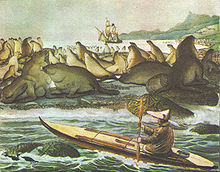Pribilof Islands
| Pribilof Islands | ||
|---|---|---|
| Map of the archipelago | ||
| Waters | Bering Sea | |
| Geographical location | 56 ° 50 ′ N , 170 ° 0 ′ W | |
|
|
||
| Number of islands | 4th | |
| Main island | Saint Paul Island | |
| Total land area | 200 km² | |
| Residents | 600 | |
The Pribilof Islands , or Pribilof Islands in English, are a group of islands of volcanic origin in the US state of Alaska . They are located north of the Aleutian Islands in the Bering Sea .
Geography and population
Politically, the Pribilof Islands belong to Alaska and essentially consist of the two inhabited islands of St. Paul and St. George . There are also three small uninhabited islands that are close to Saint Paul Island: Otter , Walrus and Sea Lion Rock . Around 450 people live on the larger island of St. Paul and around 125 people on St. George. The Pribilof Islands can only be reached by boat or via the airport on St. Paul. Due to the location of the islands, fog prevails for around 300 days a year, which makes landing aircraft difficult. The islands cover an area of about 200 km².
history

Even before their sighting in 1767 by Joan Synd and the visit of Gawriil Pribylow in 1788 , the islands were used by the Aleutians as a base for hunting; this is proven by archaeological finds z. B. on the island of St. Paul. You can still find traces of simple huts with roofs made of whale bones and animal skins.
Upon his return, Pribilof reported on the large numbers of northern fur seals . As a result, members of the Aleutian people were resettled by the Russians to hunt fur animals from Umnak and Unalaska to the Pribilof Islands. In 1825 and 1830, the two places St. Paul and St. George were founded. In 1867 the USA bought the archipelago from Russia together with Alaska ( Alaska Purchase ). Between 1890 and 1910, the North American Commercial Company had a monopoly on the seal hunt and almost completely wiped out the fur seal population; the sea otter population was wiped out. It was not until 1966 that commercial seals were banned. Only the indigenous people living here are allowed to hunt and kill around 1000 animals per year.
economy
The main branch of the economy is fishing and especially the catch of halibut and king crabs .
flora
The rocky islands are treeless and overgrown with grass or other plants of the tundra zone . Lupins can often be found here , and wild arnica is regularly found on the beaches .
fauna
In addition to the approximately 1 million individuals counted population of fur seals are mainly the rich bird life ( Schopfalke , parakeet auklet , Horned Puffin , kittiwakes , snowy owl ) is important. So far, 120 different bird species have been identified and around 2 million seabirds come to breed here every year. Furthermore, the arctic fox can regularly be seen hunting in the bird colonies on the islands .
A special feature is the rare Pribilof sand pipit .
On Saint Paul Island, which was separated from Alaska by rising sea water after the last Ice Age 13,000 years ago, a population of woolly mammoth was discovered that had survived there until the mid-Holocene. They are relatively small woolly mammoths, but their small size is not considered to be a complete island dwarf like on Wrangel Island . The most recent data from the Qagnax Cave of Sankt Paul are 5,725 BP ( 14 C years), i.e. about 3700 BCE.
literature
- Wilfred H. Osgood, Edward A. Preble, and George H. Parker: The Fur Seals and other Life of the Pribilof Islands, Alaska, in 1914 , Bullentin of the Bureau of Fisheries, Volume XXXIV, 1915, Document No. 820, edition June 19, 1915, Washington, United States Government Printing Office
- Rohina Celeste Rubicz: Evolutionary Consequences of Recently Founded Aleut Communities in the Commander and Pribilof Islands . ProQuest, 2007. ISBN 0549334475
Web links
- Helen D. Corbett and Susanne M. Swibold: The Aleuts of the Pribilof Islands, Alaska . amiq.org
Individual evidence
- ↑ JM Enk, DR Yesner, KJ Crossen, DW Veltre and DH O'Rourke: Phylogeographic Analysis of the mid-Holocene Mammoth from Qagnax Cave, St. Paul Island, Alaska. Palaeogeography, Palaeoclimatology, Palaeoecology 273 (1-2), 2009, pp. 184-190.
- ↑ Douglas W. Veltre, David R. Yesner, Kristine J. Crossen, Russell W. Graham and Joan B. Coltrain: Patterns of faunal extinction and paleoclimatic change from mid-Holocene mammoth and polar bear remains, Pribilof Islands, Alaska. Quaternary Research 2008, pp. 40-50.




